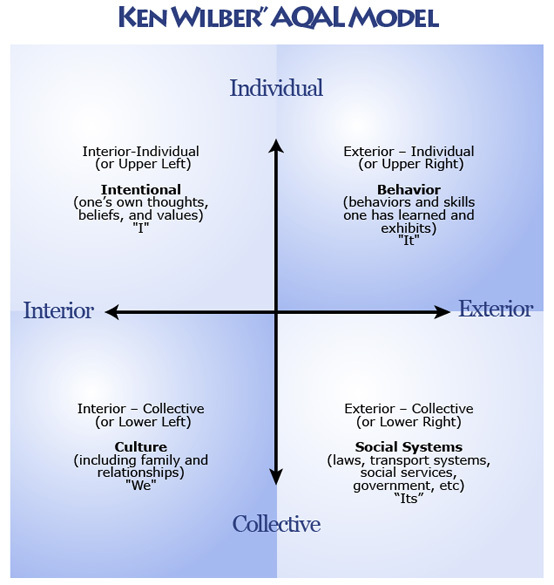Discussion Post I submitted for my Atlantic University TP5100 Course – October 7, 2020
With the addition of material from Dr. Clare Graves’ Spiral Dynamics system and the Integral Model, Ken Wilber adds significant depth to what he initially proposes in Up from Eden. As we discussed last week, Wilber’s Up from Eden theory of the evolution of consciousness included four levels with Level 1 occurring 3-6 million years ago, Level 2 covering a period of approximately 200,000-10,000 years ago, Level 3 beginning 10,000 B.C. through 1,500 B.C., and Level 4, broken into three stages, starting roughly 1,000 B.C. until today (Wilber, 1981). In his Integral Spirituality, Bunny Paine-Clemes notes that Wilber expands his four levels – or three levels when you consider that this theory begins at approximately the point of Up to Eden’s Level 2 or 100,000 years ago – to “10 major post-metaphysical levels of beings and knowing” (Paine-Clemes, 2015).
Integral Spiritual is a very similar theory to Clare Graves’ Spiral Dynamics. According to Paine-Clemes, the primary difference is the color scheme each chose with Wilber drawing upon the traditional chakra colors and Beck using “arbitrary colors” (Paine-Clemes, 2015). The additional stages or colors provide a more significant number of changes to occur in a smaller period than his original. However, nearly 100,000 years is still a lot of ground to cover. The first six colors, which are classified as Tier 1, take us from Instinctive/Survivalist 100,000 years ago to Communitarian/Egalitarian starting 150 years ago.
Another positive difference with Integral Spirality or Spiral Dynamics is that Tier two encompasses a much shorter time frame with the seventh color beginning 50 years ago and the final color starting 30 years ago. As someone alive for both of these periods, although pretty young 50 years ago, the depth and changes to our consciousness, along with technology, medicine, the culture, and everything else, is dramatic and likely more significant than any other period in history. As Paine-Clemes notes, Beck’s Turquoise stage, the period we find ourselves, is marked by the following: “Self is both distinct and a blended part of a larger, compassionate whole”; and “Holistic, intuitive thinking and cooperative actions are to be expected”(Paine-Clemes, 2015).
I found Wilber’s Integral Theory very difficult to absorb, and in particular, the four quadrants. I struggle with spatial concepts, and, as Robin notes, Wilber’s material can be very “dense.” The fact that the printout’s point size was relatively small and my black printer toner is on the way out, so the ink wasn’t very thick didn’t help either. My biggest takeaway from his theory, which again is a big expansion from his Up from Eden work, is that he includes a wide array of opinions on consciousness. Specifically, he has twelve “schools,” ranging from the purely rationalistic, such as Neuropsychology to the more esoteric, such as Eastern and contemplative traditions and Subtle energies (Wilber, 1997). Many “mainstream” researchers wouldn’t dare to touch the more “woo-woo” topics, such as near-death experiences and altered states of consciousness, so I commend Wilber for his courage. As he notes, “…[Each school] is telling us something very important (but partial) about consciousness. This is why I strongly maintain that all of these approaches are equally important for an integral view of consciousness” (Wilber, 1997).
As Robin noted in the video over the weekend, some of us, including me, believe we are experiencing a paradigm shift in consciousness as we speak. I’ve read Maureen St. Germain’s, Waking up in 5D, among other resources, and firmly believe that’s what’s happening. I’m excited about bringing a discussion of this shift into our course moving forward, as Robin suggested, which is why I find Wilber’s willingness to expand beyond where science is typically willing to go with his Integral Theory exciting. Most here, I imagine, including me, view consciousness and its evolution as something not only internal but external. Without including a study of the Nonordinary states of consciousness and the Eastern and contemplative traditions schools, among others, it’s an extremely limited and overly rationalistic view of what’s happening.
References
Paine-Clemes, B. (2015), “Spiral dynamics and evolutionary consciousness,” Virginia Beach, VA: Fourth Dimension Press. Retrieved from https://moodle.atlanticuniv.edu/mod/resource/view.php?id=43044
Wilber, K. (1997), “An integral theory of consciousness,” Journal of Consciousness Studies, 4(1), pp. 71-42. Retrieved from https://moodle.atlanticuniv.edu/pluginfile.php?file=%2F55200%2Fmod_resource%2Fcontent%2F1%2Fwww.imprint.co_.uk_Wilber.pdf.
Wilber, K. (1981), Up from eden, New York, NY: Doubleday. Retrieved from https://moodle.atlanticuniv.edu/mod/page/view.php?id=43039.
